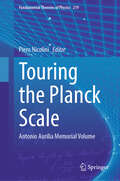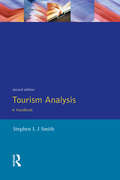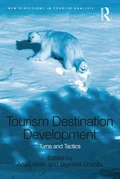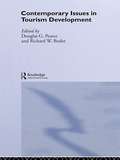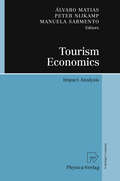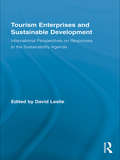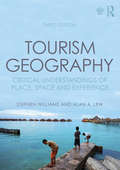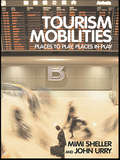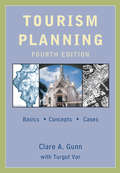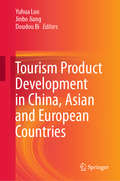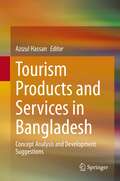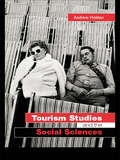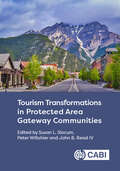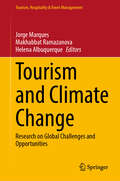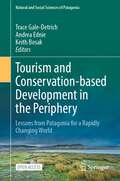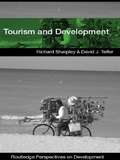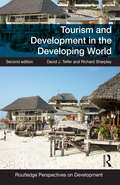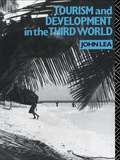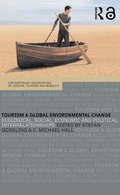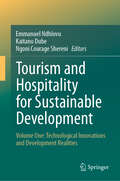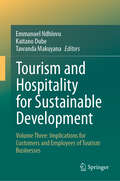- Table View
- List View
Touch the Earth (Julian Lennon White Feather Flier Advent #1)
by Bart Davis Smiljana Coh Julian LennonA New York Times bestseller that TODAY calls “beautiful” and “stunning!”This interactive book immerses children in a fun and unique journey. Jump aboard the White Feather Flier, a magical plane that can go wherever you want! Just press a button printed on the page, and point the plane up in the air to fly, or down to land it! Fly to the top of a mountain! Send clean water to thirsty people! Dive deep into the ocean (the Flier turns into a submarine!) to pick up pollution and bring back the fish! Explore the planet, meet new people, and help make the world a better place!The Flier's mission is to transport readers around the world, to engage them in helping to save the environment, and to teach one and all to love our planet.An inspiring, lyrical story, rooted in Lennon's life and work, Touch the Earth is filled with beautiful illustrations that bring the faraway world closer to young children. The book includes words to a special poem written by Julian Lennon, specifically for Touch the Earth.This is the first book in a planned trilogy. A portion of the proceeds from book sales will go to support the environmental and humanitarian efforts of the White Feather Foundation, the global environmental and humanitarian organization that Lennon founded to promote education, health, conservation, and the protection of indigenous culture.
Touring the Planck Scale: Antonio Aurilia Memorial Volume (Fundamental Theories of Physics #219)
by Piero NicoliniThis book in honor of Antonio Aurilia provides an overview of one of the most mysterious research fields in theoretical physics, namely the fundamental interactions at energies between the electroweak scale and the Planck scale. The latter includes physics beyond the Standard Model, strings and p-branes, quantum gravity, quantum black holes and early Universe cosmology. A related goal of the work is to present the physical conditions upon which some piece of evidence of new physics at extreme energies can be exposed at current (or near future) experimental facilities. The work is organized in three parts. The first part schematically introduces the problem of fundamental interactions and summarizes the life and work of Prof. Aurilia. The second part forms the body of the book. It contains contributions from internationally recognized specialists who collaborated with Prof. Aurilia, such as R. Balbinot, B. Carr, G. Dvali, A. Fabbri, P. Gaete, J. A. Helayël-Neto, R. Mann, J. Mureika, D. Singleton, A. Smailagic, E. Spallucci and P. Townsend. The third part summarizes the work and draws the conclusions with particular attention to future developments.
Tourism Analysis: A Handbook
by Stephen L SmithProvides practical advice on the use of quantitative techniques used in tourism. Thoroughly revised and updated, the new edition includes new guidelines for domestic and international statistics produced by the World Tourism Organization. The book provides practical tools for both market planning as well as for product assessment, especially regional and environmental planning.
Tourism Destination Development: Turns and Tactics (New Directions in Tourism Analysis)
by Arvid Viken Brynhild GranåSAlthough blurred and heavily contested, the concept of ’tourist destination’ still deserves careful attention. Despite its unstable characteristics, ’destination’ is a central and meaningful term in play among all parties in the field of tourism, including tourists, tourism operators, and politicians, as well as students and tourism scholars. This anthology draws on different approaches and discourses of tourism destination development, while focusing on how they are shaped and reshaped and how they should be read and rehearsed. The book reveals dominant as well as alternative approaches to the field. The authors demonstrate how tourism destinations are commercial, but socially embedded; how they are both material and territorial, but at the same time socially constructed; how production of touristic brands and images are vital, but contested. Such tensions are unfolded through paradigmatic discussions and a series of case studies from the northern hemisphere. The chapters in the book investigate how destination development is catalysed through theming, how changing environments lead to reorientations, and how destinations are political. Altogether, the book provides experts and students with an up-to-date theoretical and empirical insight into tourist destinations.
Tourism Development (Routledge Advances in Tourism)
by Richard W. Butler Douglas G. PearceThis work combines a study of contemporary issues in tourism development with a close examination of approaches to tourism research. Looking beyond the much-studied mass tourism industries, leading international academics who are members of the International Academy for the Study of Tourism, explore new issues raised by emerging tourist destinations such as Ghana, Samoa, Vietnam and India's Bhyundar Valley. A fascinating work, Contemporary Issues in Tourism Development discusses a wide range of topics such as: * reasons for development* tourism development as a strategy for urban revitalization* tourism’s links to heritage conservation and regional development* sustainability and the adverse impacts of development* cultural considerations and community participation* the importance of context for individual tourism projects.
Tourism Economics: Impact Analysis
by Peter Nijkamp Manuela Sarmento Álvaro MatiasThe assessment of local, regional or national impacts of an influx of tourists - of different kind and origin - has in recent years become a new challenge for economics research in the tourism sector. There is a clear need to develop solid methodologies through which the socio-economic impacts of tourism can be assessed. Tourism impact assessment - as a systematic approach to the estimation of socio-economic effects of tourism on relevant parts of the economy - has become a timely response to the need for appropriate information for stakeholders, both public and private. The present volume brings together a set of recent impact studies - of both a theoretical-methodological and an applied policy-oriented nature - , which have been selected on the basis of their originality or novel contribution to the research in this field.
Tourism Enterprises and Sustainable Development: International Perspectives on Responses to the Sustainability Agenda (Routledge Advances in Tourism)
by David LeslieThe tourism industry has increasingly recognized and responded to growing environmental concerns. In recent years, there has been an emergence of a variety of categories of tourism considered more environmentally friendly: green, eco-tourism, and sustainable tourism. Much of the literature that has addressed these developments has been orientated to the destination locale or specific to a development. These texts have not sought to investigate and examine the response of government/national tourist organizations to the international sustainability agenda and the responses/actions of tourism enterprises to this "greening" agenda. This text aims to address this remarkable gap. This indispensable contribution to the field provides a comprehensive, state of the art perspective on progress towards the objectives of sustainable development within the tourism sector across the globe by focusing on the environmental performance and adoption of environmental management systems by tourism enterprises.
Tourism Geography
by Stephen Wynn WilliamsThis text provides a concise introduction to new and established geographies of tourism. Using worldwide examples it examines the differing economic, environmental and sociological impacts that tourism has on destinations. It looks to the future by considering how planning for tourism can assist in furthering development and sustainable tourism.The fifteen boxed case studies include:* Heritage tourism in Yorkshire, UK* 18th and 19th Century development of Brighton, UK* Theme parks in Japan* Development of beach resorts in Thailand* Tourism enclaves in the Dominican Republic* Sustainable tourism in Australia and the USA* The impact of tourism on wildlife - the loggerhead turtle* Water quality and tourism - Rimini, Italy* Tourism and economic Development in Tunisia and The Gambia.It also explores the factors that have encouraged the growth of both domestic and international tourism and highlights ways in which patterns of tourism are evolving.
Tourism Geography: Critical Understandings of Place, Space and Experience (Contemporary Human Geography Ser.)
by Stephen Williams Alan A. LewFor human geographers, a central theme within the discipline is interpreting and understanding our changing world - a world in which geographic patterns are constantly being reworked by powerful forces of change. These forces include population shifts, new patterns of economic production and consumption, evolving social and political structures, new forms of urbanism, and globalisation and the compressions of time and space that are the product of the ongoing revolutions in information technology and telecommunications. This book attempts to show how tourism has also come to be a major force for change as an integral and indispensable part of the places in which we live, their economies and their societies. When scarcely a corner of the globe remains untouched by the influence of tourism, this is a phenomenon that we can no longer ignore. Tourism is also an intensely geographic phenomenon. It exists through the desire of people to move in search of embodied experience of other places as individuals and en mass and at scales from the local to the increasingly global. Tourism creates distinctive relationships between people (as tourists) and the host spaces, places and people they visit, which has significant implications for destination development and resource use and exploitation, which are exhibited through a range of economic, social, cultural and environmental impacts that have important implications for local geographies. This third edition of Tourism Geography: critical understandings of place, space and experience presents an essential understanding of critical perspectives on how tourism places and spaces are created and maintained. Drawing on the holistic nature of geography, a range of social science disciplinary views are presented, including both historical and contemporary perspectives. Fundamentally, however, the book strives to connect tourism to key geographical concepts of globalisation, mobility, production and consumption, physical landscapes, and post-industrial change. The book is arranged in five parts. Part I provides an overview of fundamental tourism definitions and concepts, along with an introduction to some of the major themes in contemporary geographic research on tourism, which are further developed in subsequent chapters of this book. In Part II the discussion focuses on how spatial patterns of modern tourism have evolved through time from regional to global geographies. Part III offers an extended discussion of how tourism relates to places that are toured through their economic landscape, contemporary environmental change and socio-cultural relations. Part IV explores a range of major themes in the geographies of tourism, including place creation and promotion, the transformation of urban tourism, heritage and place identity, and creating personal identity through consumption, encounters with nature and other embodied forms of tourism experience. Part V turns to applied geography with an overview of the different roles of planning for tourism as a means of spatial regulation of the activity, and a look at emerging themes in the critical geography of contemporary and future geographies of tourism. This third edition has been revised by Dr Alan A. Lew, who becomes the new co-author of Tourism Geography. Some of the major revisions that I have incorporated include moving most of the case study boxes to the website http://tourismgeography.com, which will provide a growing wealth of new case studies, over time. I have also incorporated new material, reorganised some of the content to balance the topics covered, created a new concluding chapter that explores some recently emerging perspectives in critical tourism geography, and re-written the text to make it more accessible to a global English-speaking world. That said, the book is still very much the work of Dr Stephen Williams. As such, it maintains its original concise yet comprehensive review of contemporary tourism geography and the ways in which geographers critically interpret this important global phenomenon. It is written as an int...
Tourism Management in Warm-water Island Destinations
by Michelle McLeod Robertico CroesWarm-water islands are a cohesive group of islands distinguished by their geography and remoteness, history as former colonial territories, and dependence on external stakeholders for their economic and social development. Warm-water island destinations also have a year-round tourism industry. These island tourism destinations are facing unprecedented adjustment challenges in the wake of increasing globalization and susceptibility to external shocks, and are in search of appropriate policy responses to that globalization. It is critical for small islands to understand how these challenges affect tourism performance and how they impact their residents. Tourism Management in Warm-water Island Destinations unearths the critical aspects that contribute to tourism development and growth in islands. Particular emphasis is placed on destinations such as the Caribbean, with lessons learned that are applicable to other island tourism contexts in the Mediterranean, Indian Ocean and the Pacific. · Presents emerging research themes and methodology; · Provides insight into factors that result in successful and unsuccessful cases; · Features a focus on Cuba and its reintroduction to the tourism landscape. This book provides a platform for emerging systemic perspectives of the various aspects of island tourism, with the view that strategies for the management and development of tourism in island environments can be improved and will be of interest to those studying and researching within destination management.
Tourism Mobilities: Places to Play, Places in Play
by Mimi Sheller John UrryMany places around the world are being produced, converted, interpreted and made fit for tourist consumption. This fascinating book analyzes tourist performances such as walking, shopping, sunbathing, photographing, eating and clubbing, and studies why, and indeed how, some places become global centres whilst others don’t. Arranged in four distinct parts, Sheller and Urry consider: Performing Paradise Performances of Global Heritage Remaking Playful Places New Playful Places. Incorporating a wide array of empirical research and innovative international case studies, this fascinating book illuminates the tourist performance phenomenon: from Eco-tourism on the beach to shopping in Hong Kong, from the making of 'Cool Reykjavik' to tourism in high-rise suburbs in Paris, and from Inca heritage to medical tourism. Edited by two world authorities in tourism studies, this revealing book deploys a range of theories related to the 'mobility turn' in the social sciences in order to analyze the contingent and networked nature of how places are stabilized as fit for playful performances. Well-written and researched, with coherent analysis and presentation, this book will appeal to academics, students and those interested in the complex character of global change.
Tourism Planning: Basics, Concepts, Cases
by Turgut Var Clare GunnAs one of the fastest growing sectors of the economy since the 1950s, tourism has proved to be a complicated phenomenon, unlike any other economic producer. Over the last few decades, tourism has exerted increasing pressure on the land and negative social, environmental and economic impacts have surfaced as major issues. Positive guidelines for better planning are in demand by developers and designers who need new understandings of the breadth of tourism's complexity for their own success. Long considered the seminal work on tourism development, Tourism Planning provides a comprehensive, integrated overview of all aspects of tourism and the planning functions that accompany it, emphasizing concepts and principles for better planning.
Tourism Product Development in China, Asian and European Countries
by Yuhua Luo Jinbo Jiang Doudou BiThis book analyzes a broad variety of tourism products in China, Asia and Europe that employ both cutting-edge IT technologies and advanced methodologies. These products are cultural tourism, recreational tourism, sport tourism, adventure tourism, medical tourism and more. Authors from different areas contributed to the book, including academic researchers, graduate students, government administrators and industry practitioners. The book covers the entire chain of tourism product business processes: product development and improvement, tourist behavior analysis, marketing and sales, customer service, etc. In addition, it addresses related issues such as tourism sustainability, policymaking, environmental protection and human resource development. Big data processing, data mining, visual content analysis and textural content analysis, semantic nets and sentiment analysis are among the cutting-edge technological tools used to study tourism product development here. The book gathers selected papers from the 9th International Conference on Tourism and Hospitality between China and Spain (www.china-spain.org) with participants from 18 countries. Though the book is mainly intended for researchers and policymakers, it will also appeal to a wider audience, due to its first-hand content, insightful analysis and broad geographic coverage.
Tourism Products and Services in Bangladesh: Concept Analysis and Development Suggestions
by Azizul HassanThis book provides the latest research in the application of innovative technology to the tourism industry in Bangladesh, covering the perspectives, theories, issues, complexities, as well as opportunities and the challenges present. This book provides a blend of comprehensive and cross disciplinary as well as international insights from contributors to cover the various technologies in tourism. This book focuses on the importance of technologies in tourism, specifically the application and practice of such technologies including the relevant niches in tourism. This book also comprehensively highlights technologies that are impacting the tourism industry in Asia as well as reveals the specific constraints. The contents of this book deal with distinct topics such as mobile computing, new product designs, innovative technology usages in tourism promotion, technology-driven sustainable tourism development, location-based apps, mobility, accessibility and so on. This book is a significant contribution towards the very limited knowledge and under published area of tourism in Bangladesh. This book is designed to accommodate readers that from both both qualitative and quantitative research theory and practices. This book identifies specific examples of the existing tourism products and services in order to better promote and boost the tourism industry by suggesting tourism products and services available in Bangladesh. This book addresses a number of key issues and solutions by examining the products and services and the need for improved tourism marketing and development in Bangladesh as the central themes.
Tourism Studies and the Social Sciences
by Andrew HoldenBased upon a social science approach to understanding the significance of tourism in contemporary society, Andrew Holden’s fascinating book highlights tourism as a multidisciplinary area of study with rich and varied theoretical underpinnings. Here, Holden introduces social science disciplines and applies relevant theories to the understanding of tourism. He investigates how the economic and political structures of society influence the manifestation of tourism at a global level, and subsequently considers a variety of topical issues including citizenship and social exclusion, tourism as a form of trade, consumerism, the consequences of tourism, and feminism and ethics. Each chapter includes: a brief introductory summary of the discipline a critique of its main theories and concepts which have relevance to tourism a discussion of how the theories and concepts have been applied to tourism using cases and examples international case studies and examples. Punctuated with study and teaching aids, chapter summaries and ‘think points’ to encourage reflection, this excellent, broad-ranging textbook provides a wider understanding of tourism’s role in society.
Tourism Transformations in Protected Area Gateway Communities
by Gianna Moscardo C. Michael Hall Kynda R. Curtis Professor Chris Ryan Dorothee Bohn Andrea Zita Botelho Kelly S. Bricker Robert S. Bristow Karina H. Casimiro Rosa Suárez Chaparro Ana Cristina Costa Margaret J. Daniels Edieser Dela Santa Manuel Ramón Herrera Russell M. Hicks Julie Judkins N. Qwynne Lackey Natalya Lawrence Gustavo C. Machado Jake Powell Sidnei Raimundo Mary Anne Ramos-Tumanan Milena Manhães Rodrigues Renato De Santos Jessica A. Schottanes Ole R. Sleipness Maria Anunciação Ventura Therez B. WalkerGateway communities that neighbour parks and protected areas are impacted by tourism, while facing unique circumstances related to protected area management. Economic dependency remains a serious challenge for these communities, especially in a climate of neoliberalism, top-down policy environments, and park closures related to environmental degradation or government budgets. The collection of works in this edited book provide bottom-up, informed, and nuanced approaches to tourism management using local experiences from gateway communities and protected areas management emerging from a decade of guidelines, rulemaking, and exclusive decision-making. Global perspectives are presented and contextualized at the local level of gateway communities in an attempt to balance nature, community, and commerce, while supporting the triple bottom line of sustainable tourism. While anticipating a post-COVID 19 global shift, readers are encouraged to think through transformation and resiliency in regard to how the flux of supply vs demand alters gateway community perspectives on tourism. Specific features of this book include: · Focus on transformations, which provides insight into the complex and dynamic nature of gateway communities. · Multidisciplinary, multi-cultural insights into protected area management. · Applied and conceptual chapters from global perspectives.
Tourism and Climate Change: Research on Global Challenges and Opportunities (Tourism, Hospitality & Event Management)
by Helena Albuquerque Jorge Marques Makhabbat RamazanovaThis book focuses on the intricate relationship between climate change and the tourism industry, examining the challenges and opportunities arising from this global phenomenon. The tourism sector, a significant contributor to both the acceleration and impact of climate change, is scrutinized for its carbon footprint in transportation and accommodation. The direct consequences of extreme weather events further compound the complexity. However, within these challenges lies the potential for positive transformation. The book explores the role of the tourism industry as a catalyst for sustainable practices and environmental conservation. Through an examination of resilient strategies, it aims to provide insights into fostering a harmonious relationship between tourism and the environment, thereby ensuring a positive impact in the context of a changing climate.
Tourism and Conservation-based Development in the Periphery: Lessons from Patagonia for a Rapidly Changing World (Natural and Social Sciences of Patagonia)
by Keith Bosak Trace Gale-Detrich Andrea EdnieThis open access book applies a social ecological systems (SES) lens to conservation-based development in Patagonia, bringing together authors with historical, contemporary, and future-oriented perspectives in order to increase understanding of the social and environmental implications of nature-based tourism and other forms of conservation-based territorial development. By focusing on Patagonia (as a region) and its various forms of conservation-based development, this book contributes one of the first collections of South American based lessons and will be valuable to researchers and practitioners, both locally and around the world, seeking to better understand complex interconnections between social and ecological environments, and pursue a similar path to resilience and sustainability.
Tourism and Development in the Developing World
by Richard Sharpley David J. TelferTourism is widely considered as an effective contributor to socio-economic development, particularly in less developed countries. However, despite the almost universal adoption of tourism as a developmental option, the extent to which economic and social development inevitably follows the introduction and promotion of a tourism sector remains the subject of intense debate. This book provides an introduction to the tourism-development process. Focusing specifically on the less developed world and drawing on contemporary case studies, it questions many assumptions about the role of tourism in development and, in particular, highlights the dilemmas faced by destinations seeking to achieve development through tourism. Combining an overview of essential concepts, theories and knowledge related to tourism and development with an analysis of contemporary issues and debates, Tourism and Development in the Developing World is a valuable resource for those investigating tourism issues in developing countries. It is also useful for students studying related subjects, including development studies, geography, international relations, politics, sociology and area studies.
Tourism and Development in the Developing World (Routledge Perspectives on Development)
by Richard Sharpley David J. TelferTourism is widely considered to be an important factor in socio-economic development, particularly in less developed countries. However, despite almost universal recognition of tourism’s development potential, the extent to which economic and social progress is linked to the growth of a country’s tourism sector remains the subject of intense debate. Tourism and Development in the Developing World offers a thorough overview of the tourism-development relationship. Focusing specifically on the less developed world and drawing on contemporary case studies, this updated second edition questions widely-held assumptions on the role of tourism in development and seeks to highlight the challenges faced by destinations seeking to achieve development through tourism. The introductory chapter establishes the foundation for the book, exploring the meaning and objectives of development, reviewing theoretical perspectives on the developmental process, and assessing the reasons why less developed countries are attracted to tourism as a development option. The concept of sustainable development, as the most widely adopted contemporary model of development, is then introduced and its links with tourism critically assessed. Subsequent chapters explore the key issues associated with tourism and development, including the rise of globalization; the tourism planning and development process; the relationship between tourism and communities within which it is developed; the management implications of trends in the demand for and uptake of tourism; and an analysis of the consequences of tourism development for destination environments, economies and societies. A new chapter considers the challenges of climate change, sustainability of resource supply (oil, water and food), global economic instability, political instability and changing demographics. Finally, the issues raised throughout the book are drawn together in a concluding chapter that assesses the tourism and development ‘dilemma’. Combining an overview of essential concepts, theories and knowledge with an analysis of contemporary issues and debates in tourism and development, this new edition will be an invaluable resource for those investigating tourism issues in developing countries. The book will be of interest to students of tourism, development, geography and area studies, international relations and politics, and sociology. ?
Tourism and Development in the Third World
by John LeaWhat is the thruth behind the paradise beaches in travel brocures? What can a developing country do when one exotic holiday seems much like another, when political instability or environmental disaster can deter tourist for years, when the tourism industry slips into foreign control?Tourism and Development in the Third World assess the diverse social, economic, and environmental factors which impact on the Third World. Illustrating the analysis with cases which range across tourism in game parks, sex tours and the after-efects of political turmoil, the book explores ways of managing tourism as a resource and evaluates its long-term contribution towards national development.
Tourism and Gastronomy (Routledge Advances in Tourism #No.11)
by Greg Richards Anne-Mette HjalagerIn recent years, a growing emphasis has been placed on tourism experiences and attractions related to food. In many cases eating out while on holiday includes the 'consumption' of a local heritage, comparable to what is experienced when visiting historical sites and museums.Despite this increasing attention, however, systematic research on the subject has been nearly absent. Tourism and Gastronomy addresses this by drawing together a group of international experts in order to develop a better understanding of the role, development and future of gastronomy and culinary heritage in tourism.Students and researchers in the areas of tourism, heritage, hospitality, hotel management and catering will find this book an extremely valuable source of information.
Tourism and Global Environmental Change: Ecological, Economic, Social and Political Interrelationships (Contemporary Geographies of Leisure, Tourism and Mobility)
by C. Michael Hall Stefan GösslingThis fascinating book is the first comprehensive analysis of the economic, social and political interrelationships between tourism and global environmental change: one of the most significant issues facing humankind today. Its contributors argue that the impacts of these changes are potentially extremely serious both for the tourism industry, and for the communities dependent upon it. Integrating knowledge from the social and physical sciences, this significant book explores they key issues surrounding global environmental change, as well as government and industry willingness to meet the challenges posed by it. Divided into four main sections, it investigates: the tourism and global environmental change relationship in specific environments global issues related to environmental change differing perceptions of global environmental change held by tourists and the tourist industry. Comprehensive in scope, topical and integrative, this key text is essential reading for students, scholars and researchers in all aspects of tourism, geography and environmental studies.
Tourism and Hospitality for Sustainable Development: Volume One: Technological Innovations and Development Realities
by Kaitano Dube Emmanuel Ndhlovu Ngoni Courage ShereniThe tourism and hospitality industry in the 21st century cannot be adequately planned, executed, marketed, managed, or studied without taking into account digital technology and its impact. The Fourth Industrial Revolution provides the framework for sustainable development in this sector. Technology not only increases profitability but also enables the industry to effectively respond to pressing global sustainability challenges such as pandemics, climate change, energy crises, staffing shortages, and hyperinflation. Moreover, technology allows the industry to consider its current and future economic, social, and environmental consequences, addressing the needs of tourists, the industry, the environment, and destinations. However, implementing technology efficiently and ethically is a complex process, and the opportunities, costs, and challenges vary depending on the geopolitical and socio-economic context. The application of digitalisation and technological innovations have played a significant role in promoting universal design and reasonable accommodation for older adults and individuals with disabilities in both developed and developing countries. These advancements are crucial for the growth of accessible tourism and hospitality. This edited book aims to explore the trends, challenges, and complexities of integrating digitalisation and technology into the tourism and hospitality industry. It also examines the strategic shifts that will shape future research in this area. The book provides a comprehensive overview of the current state of research, including theoretical insights, empirical evidence, and evidence-based recommendations. It covers a range of technologies, such as blockchain, robots, artificial intelligence, virtual reality, big data, and analytics. The goal is to understand how these disruptive technologies are being used and their potential impact on various stakeholders, as well as their future possibilities and limitations.
Tourism and Hospitality for Sustainable Development: Volume Three: Implications for Customers and Employees of Tourism Businesses
by Kaitano Dube Emmanuel Ndhlovu Tawanda MakuyanaThe travel and hospitality industry in the 21st century cannot be conceived, planned, advertised, run, or researched without the use of digital technology and innovation. Sustainable development in this sector cannot be achieved without considering the Fourth Industrial Revolution. The use of technology not only enhances the industry's profitability but also helps it to respond effectively to pressing global sustainability issues such as pandemics, climate change, energy crises, workforce shortages, and hyperinflation. Furthermore, technology allows the sector to fully evaluate its current and future economic, social, and environmental impacts, addressing the needs of tourists, businesses, the environment, and destinations. However, implementing technology is not a simple process and involves various opportunities, costs, and challenges that differ depending on the geopolitical and socio-economic context. With the drive towards disability inclusion, digitalisation, technological innovations, and inventions can play a significant role in universal design and reasonable accommodation for older people and populations with disabilities in the Global North and South—such forms one of the key pillars of accessible tourism and hospitality. In the context of the above and in response to the thoughtful need for new and sustained study of the developments, interrelationships, potentialities of the topic, and synergies, this edited book explores the trends, opportunities, challenges, and complexities of digitalisation and technology integration in the tourism and hospitality industry, as well as strategic shifts that will contribute to emerging research streams. The book comprises contributions that generate theoretical insights, empirical findings, and evidence-based recommendations by focusing on emerging and forecasted technologies used in the tourism and hospitality industry, such as blockchains, robots, Artificial Intelligence, Virtual Reality, big data, and analytics. The aim is to provide a better understanding of how disruptive technologies and digitalisation are currently being utilised and how they currently and potentially influence various stakeholder groups, as well as their future possibilities and impossibilities. The third volume, in a three-volume set, primarily covers how these new technologies impact consumers and employees of tourism-related services.

